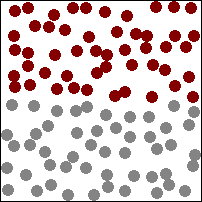 I will start teaching diffusion in a few weeks. Diffusion is how everything from gas and liquid molecules to small particles in a liquid move around – when there is no flow. As usual I will be telling some small lies. I will say something like “Diffusion of particle can be described as a random walk, a succession of steps taken in random directions.” This is not quite true.
I will start teaching diffusion in a few weeks. Diffusion is how everything from gas and liquid molecules to small particles in a liquid move around – when there is no flow. As usual I will be telling some small lies. I will say something like “Diffusion of particle can be described as a random walk, a succession of steps taken in random directions.” This is not quite true.
In any lecture, you need to keep things simple and focus on the essential. Treating the diffusion as a random walk is a very good model. You can even see Einstein using it in an English translation, or the original German of one of his classic 1905 papers. I was reminded of the fact this model is a simplification by a paper in last week’s Nature, by Franosch et al. which studied how this simple model of diffusion breaks down if you look very carefully. The fact that you have to look very carefully to see this is why I just teach the simple model.
The random-walk model says that the particle (or molecule in a gas or liquid) rattles round like a pinball, and crucially after a few collisions each of which changes its direction, completely forgets what direction it was heading in a while ago. This is not quite true and there is a fundamental reason why this cannot be completely correct: momentum is conserved and so the momentum it had when it was moving in its original direction can’t just disappear, that would violate the conservation of momentum.
In fact as momentum can neither be created nor destroyed, the only thing the momentum associated with movement along the original direction can do is diffuse slowly away. This takes time and until it is done, the particle cannot forget its original direction, it is still surrounded by this momentum slowing diffusing away, which reminds the particle of its original direction.
This is a bit confusing: to be clear, diffusion of the position of a particle is not a simple random sequence of steps becaucse of diffusion of another thing, momentum.
Franosch et al. studied how a particle in a liquid moves very carefully and saw evidence for this. I think that is quite cool. The diffusion of particles is often called Brownian Motion and has been teaching us fundamental stuff about physics since it was discovered by the botantist Robert Brown in the 19th century.
But I will stick to the small lie in my lectures, a random walk is a good model 99% of the time, and if it is good enough for Albert Einstein I guess it is good enough for me.
